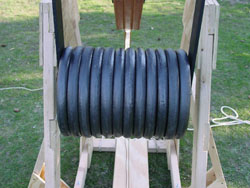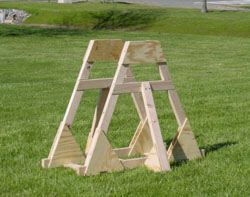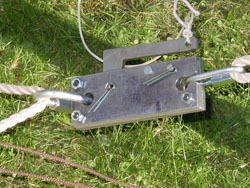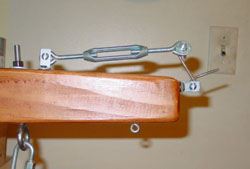The Melon Felon

The Melon Felon was built in April 2006 for competition in the 2006 RIT ASME Watermelon Launch. The rules for the competition, among others, stipulated a 4 foot by 8 foot maximum footprint, rising a maximum of 4 feet high. Through e-mails with the competition coordinator, it was decided that an arm extending out of this box would be fine if it was removable and fit within the 4x8x4 foot box, and that we could mount it and be ready to fire within the required 5 minute window. We determined that we could meet this requirement, and anticipated that we could find 3 pound watermelons, the smallest size that was allowed in the competition. That more or less dictated the size of our counterweight, which we decided would be 300 pounds. This counterweight was to be comprised of 25 pound standard plate weights, which would make it reasonably simple to adjust the weight as needed.

And so, design went forward and frame construction began. We only had about 5 weeks before the competition, so things moved forward quickly. The main frame was made from 2"x4" lumber, and was mostly done in one day. 1/2" plywood gussets and other touches were added the next weekend. The arm was built in evenings following that, made of a 7.5 foot length of 2"x6" standard lumber, tapered on the long side, and tripled up around the two axle holes. Now we just needed to do some metal work.

Since we were carrying a 300 pound counterweight, we felt that reinforcement of the arm with some metal would ensure that the wooden arm would not fail on us. Further, metal hangers were necessary for this large a counterweight. We also needed 3 1" axles, one for the main axle, one for the counterweight axle (since standard plate weights have a 1 1/16" hole), and one for the hanger axle. So, a trip to a local metal scrap shop was made, and 1/4" plate was obtained for the arm reinforcements, 3/8" plate for the hangers, a 1" axle for the counterweight axle, and a 1.125" axle for the hanger axle. We did not find a suitable piece for our main axle. With a 20" frame separation, a very high-yield steel was needed so we would not get a complete axle failure. We could have gotten a larger diameter axle, but Matt had been given 2 very nice 1" pillow block bearings a few years before, and we did not wish to have to buy new ones for a larger axle. Jason's dad came through for us on that one and got us a 2 foot length of 1" diameter 4140 steel, with a yield strength in excess of 100,000 psi, which we calculated to be the bare minimum that would stand up. Still, this was our best shot of now having a failure. An afternoon of machining later, and we were all set to set up and fire for the first time.
There was little time to tune the machine, and we also did not get our full counterweight until the day before the competition. Due to this, the Melon Felon performed poorly at the 2006 Watermelon Launch, but we continued work in the fall on addressing the issues that had appeared during the spring. The jury-rigged trigger that we had used was rather inconsistent, and more often than not failed to trigger at all, making for some scary moments trying to re-safe the machine. After seeing some ideas at The Hurl for some quick release-style triggers, we drew up plans for our own, and machined up the trigger found in the plans section on this website. Even under the full 300 pound counterweight load, the trigger can be triggered with very little effort, and yet it will not fire by accident.

We also added an adjustable release pin to the arm, in place of the simple bent pin that we had been using. The new release pin meant that we could fine-tune release points now, which would help squeeze the most distance possible out of this machine. Also in the fall, we painted the metal flats to stop them from rusting further. The arm was also sanded smooth and stained to seal it up. We were in pretty good shape for testing in the spring for returning to the Watermelon Launch, but it was not held in 2007, much to our disappointment.

We have launched many different objects with the Melon Felon, since it can carry such a large counterweight thus enabling many different weights to be launched. Soccer balls seem to be our most common projectile, usually launched by a 150 pound counterweight. We have hit upwards of 250 feet in this configuration. We have also launched baseballs from this trebuchet, though it is far from suited for this. Due to its really heavy arm, a 150 pound counterweight got the baseball to only go roughly 375 feet. While this is pretty good for a 4 foot tall machine, it required most of the 150 pound counterweight just to swing the arm at a decent speed. Watermelons, of course, have been launched, and these ranged in weight from 5 pounds to 6 pounds, with our best distance having come in at 86 feet, although this shot was far from the best possible release. And now we tend to test with a 4 pound medicine ball, and while we are still working on the tuning, 110 feet has been hit with a 200 pound counterweight with a bad release. We feel that distances around 200-250 feet should be attainable with our full 300 pound counterweight.
Overall statistics on this trebuchet:
| Height | 46 inches to the axle |
| Arm | 92" long overall -- 71" long arm, 16" short arm |
| Width | 47" including outriggers, 23" without |
| Length | 54" long |
| Axle | 1" 4140 alloy steel, 20" span |
| Counterweight | Up to 300 pounds, comprised of 25 pound standard plate weights |
| Projectiles/Normal Range | baseballs -- 375 feet with 150 pound counterweight soccer balls -- 250 feet 5-6 pound watermelons -- 86 feet, but badly tuned 4 pound medicine ball -- 110 feet, still tuning for more |
Visit the Melon Felon Image Gallery to view more pictures of this trebuchet.









